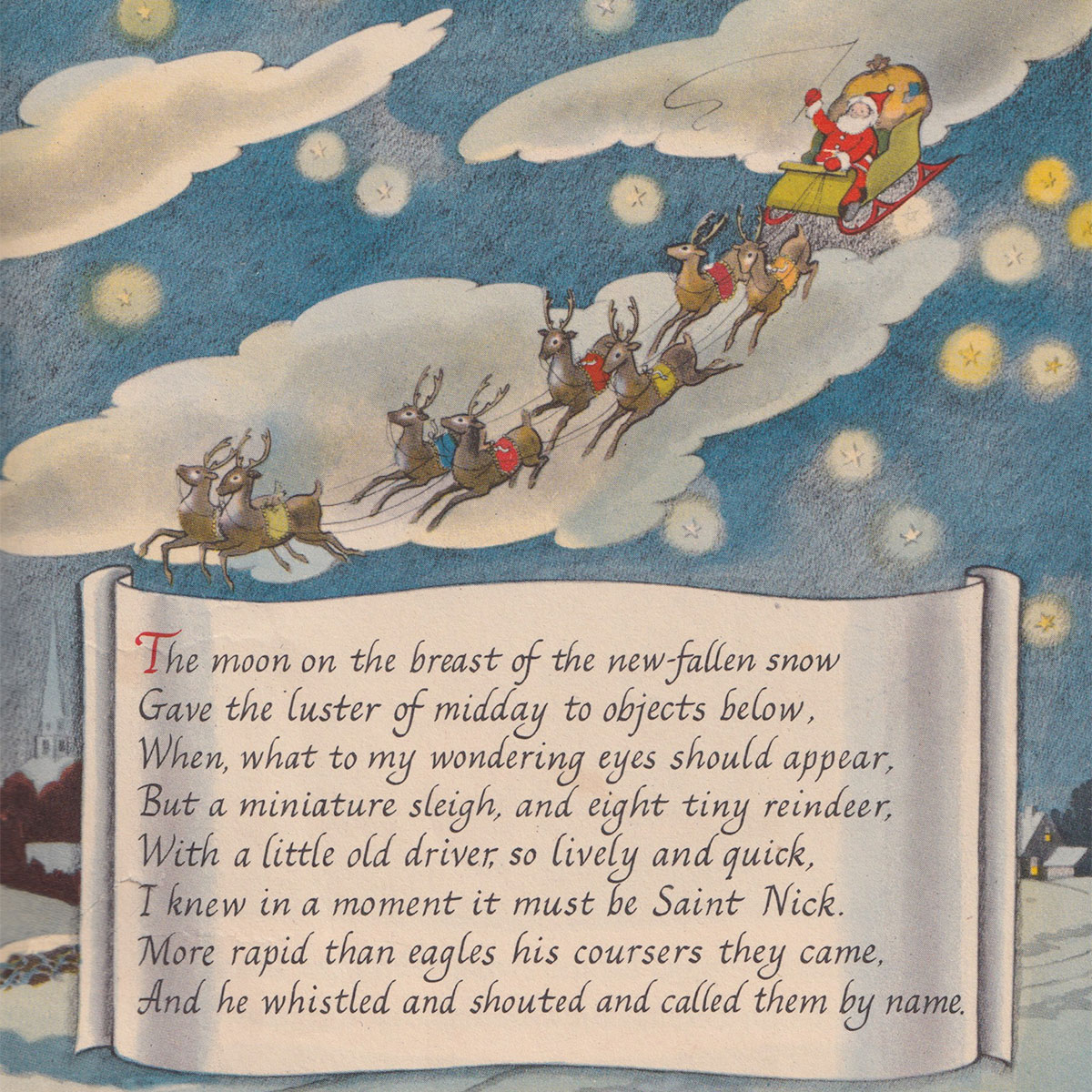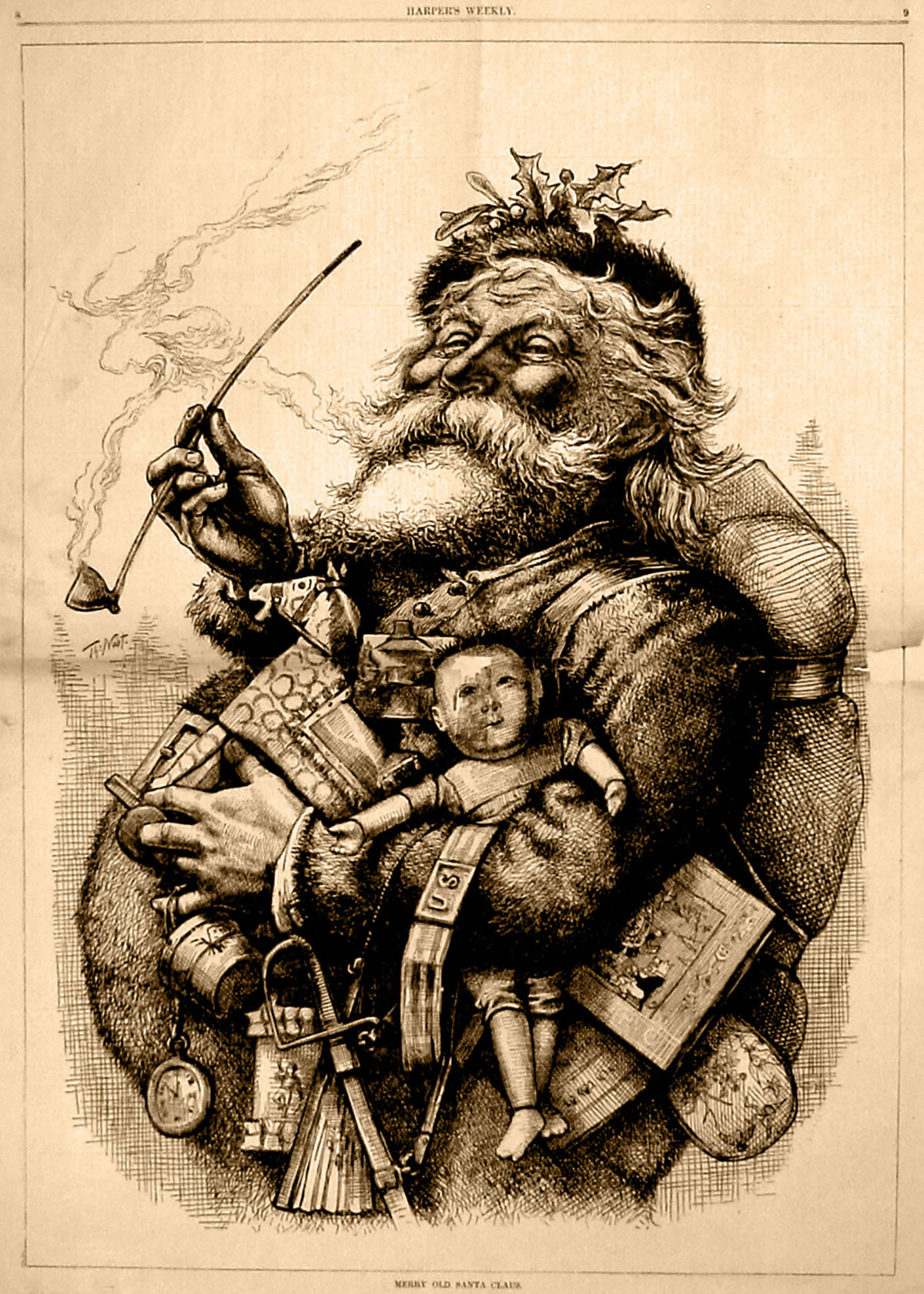’Twas the night before Christmas, and all through the house
Not a creature was stirring, not even a mouse;
The stockings were hung by the chimney with care,
In hopes that St. Nicholas soon would be there.
Without a doubt the most popular Christian holiday in the west is Christmas; and this poem by Clement C. Moore, “A Visit from St. Nicholas,” is surely one of the most recognizable and beloved. The description of Santa Claus flying through the air on a sleigh drawn by eight reindeer is both fantastic and unforgettable.
The moon on the breast of the new-fallen snow
Gave a luster of midday to objects below,
When, what to my wondering eyes should appear,
But a miniature sleigh and eight tiny reindeer,
With a little old driver so lively and quick,
I knew in a moment it must be St. Nick.

But whence came such other-worldly imagery?
Saint Nicholas Becomes Santa Claus
Most people would be surprised to learn that throughout the first thousand years of Christianity’s history, the birth of Christ was not a terribly important date in the liturgical calendar. Right up until well into the Middle Ages, it was Christ’s resurrection at Eastertime that was most celebrated. However, as we pointed out in an earlier blog on the historical origins of outdoor Nativity scenes, the beginnings of what we might recognize as a modern Christmas celebration can be traced back to the year 1223. That was the year St. Francis of Assisi, inspired by a recent trip to the Holy land, staged a celebratory “Nativity Scene” in Greccio, Italy. It proved so popular that the tradition of celebrating Christmas with gift-giving and Nativity scenes was born and rapidly spread throughout Europe.
Around the same time, the reputation of an early Christian saint named Nicholas, Bishop of Myra, had grown to such an extent that he too was now a favorite of the people. Born in the third century A.D. in what is today the nation of Turkey, he became known as the protector and patron saint of children. Indeed, by the Renaissance era, he was the most popular saint in Europe. Since the anniversary of his death fell on December 6, it was only natural that his feast day and Christmas Day should become associated in some way.
Fast-forward to 19th century Holland, Belgium, Luxembourg, and northern France, where the feast of St. Nicholas had morphed into the modern tradition of “Sinterklaas” as a more secularized children’s holiday. In 1850 a teacher named Jan Schenkman (1806–1863) wrote an illustrated children’s book titled Saint Nicholas and His Servant, in which Sinterklaas is shown delivering presents through the chimney and riding over the roofs of houses on a magical horse.
From Horse to Reindeer
As can be seen, the modern figure of Santa Claus draws many of his features from Dutch, German, and Scandinavian folklore. But now we leap across the Atlantic ocean to add two more ingredients.
The first is when American author Washington Irving, writing in 1812 in A Complete History of New York, described St. Nicholas as “riding over the tops of the trees, in that self-same wagon wherein he brings his yearly presents to children.” He fails to mention how said wagon is propelled. For that we need to jump ahead nine years, when New York printer William Gilley published a 16-page booklet titled A New Year’s Present, to the Little Ones from Five to Twelve, Number III: The Children’s Friend. That is where the anonymous author introduces reindeer into the narrative:
Old Santeclaus with much delight
His reindeer drives this frosty night.
O’er chimneytops, and tracks of snow,
To bring his yearly gifts to you.
The illustration to the first verse of the poem features Santa Claus sitting in a sleigh being pulled by a single reindeer—quite likely the very first depiction of that tradition.

(Source)
It goes without saying that an early Christian bishop from Turkey would know nothing about reindeer. But as his legend grew and spread, it needed a little magic. And why not reindeer, which once were viewed as mystical creatures from the foggy, misty, mysterious north? Not only that, it was known that they could be domesticated in Scandinavian countries and were used by the Laplanders to pull sleds and transport goods.
Clement C. Moore’s Masterpiece Sets the Santa Sleigh and Reindeer Tradition in Stone
The following year, on December 23, 1823, the Troy Sentinel newspaper of Troy, New York, published (anonymously) a poem by Clement C. Moore, an Episcopal minister, that he had written for his daughters.

(Source)
In this poem, entitled “An Account of a Visit from St. Nicholas” (but which nowadays is popularly known as “’Twas the Night Before Christmas”), all the familiar elements of the Santa Claus legend are brought together: the sleigh pulled by flying reindeer, the nighttime arrival, the entrance via chimney, the bottomless bag of gifts for children, and of course the appearance of a “right jolly old elf,” in his legendary suit and holding a sack full of gifts. It was a depiction that became so fixed in the popular imagination that even the famous political cartoonist, Thomas Nast, could not help but be inspired by it 60 years later.

(Source)
Moore even went to the trouble of naming the eight reindeer:
Now, Dasher! now, Dancer! now Prancer and Vixen!
On, Comet! on, Cupid! on, Donner and Blitzen!
A ninth reindeer, the ever-popular and ultra-heroic Rudolph, was added in 1939 as a promotional gimmick for the Montgomery Ward department stores, which we have discussed in an earlier blog.
To this day, the imagery in Moore’s poem popularized the now-familiar image of Santa Claus, flying from house to house on Christmas Eve in “a miniature sleigh” led by eight reindeer, unhindered by gravity, to leave presents for deserving children.
Santa’s Sleigh and Reindeer in the Modern Era
“Yes, Virginia, there is a Santa Claus.”
— Francis Pharcellus Church
Sadly, the tradeoff with advanced science and technology is that a little of the magic of the world leaks out. But that doesn’t mean we can’t adapt! For example, some clever fellow has figured out that the rustic exterior of Santa’s sleigh actually conceals state-of-the-art electronics and navigation equipment. And every Christmas Eve, for over half a century, the North American Aerospace Defense Command (NORAD) has been tracking the progress of Santa’s sleigh and reindeer as they make their way across the globe, visiting the home of every good child on Earth.
You too can make that magic come alive in your own home, church, or place of business with one of our high-quality, life-size Santa Sleigh and Reindeer displays from Christmas Night Inc.



